Lecture 7-《英语词汇学》第七章教案讲稿
- 格式:doc
- 大小:62.50 KB
- 文档页数:8

《英语词汇学》课程教学大纲课程编码:30615008 学分: 2 总学时:36说明【课程性质】《英语词汇学》为英语专业的专业任意选修课程。
【教学目的】本课程是英语专业高年级阶段的一门专业任意选修课。
本课程的教学目的在于要求学生掌握英语词汇学的基本知识和基本理论,从而更科学地学习英语词汇,运用词汇学中所学到的基本知识和理论来分析和理解英语词汇,正确地使用英语词汇。
【教学任务】《英语词汇学》以帮助学生扩大词汇量,有效运用英语词汇;更深入的理解词义,更有效的组织划分和贮存词汇;增强学生对词义和用法的了解,使学生准确使用词汇;使学生掌握使用参考书的技能,增加解决问题的能力和学习英语的有效性;提高学生的语言接受能力和语言使用能力为教学任务。
【教学内容】词的基本知识、英语的亲属关系与英语词汇的形成和发展、词的形态结构和构成方法、词的意义、语义关系、词义的演变、英语习语、英语词典【教学原则和方法】教学原则:本课程采用张维友编写的《英语词汇学教程》(华中师范大学出版社)为主要教材,在教学过程中坚持以学生为主体,教师为指导的原则,以教材为中心,并适时地向学生介绍英语词汇学的研究动态和最新方向,让学生对词汇学有一个全面系统的了解。
教学方法:在教学过程中,采用论述式、概述式和指引式讲解相结合对教学内容的新信息点、重点、难点进行论述式讲解,深入浅出地详述理论原理,用恰当的例证加以说明,以此帮助学生充分理解理论知识。
对容易懂的内容则进行简明扼要地讲解。
教学中以学习指定的教材为主,适当穿插一些相关的信息材料。
通过对英语词汇学中相关的概念即理论知识的学习和理解,要求学生尽量独立完成教材各部分后面所附的练习,必要时教师可给予适当的指导。
教学手段主要是抽取各部分中的精华部分进行讲解,并适时地采用专题讨论的方式进行学习。
【先修课程要求】要求学生具备英语语音、英语语法、基础英语、英语阅读、英语写作以及翻译等课程知识。
教材:张维友《英语词汇学教程》华中师范大学出版社,2004年。
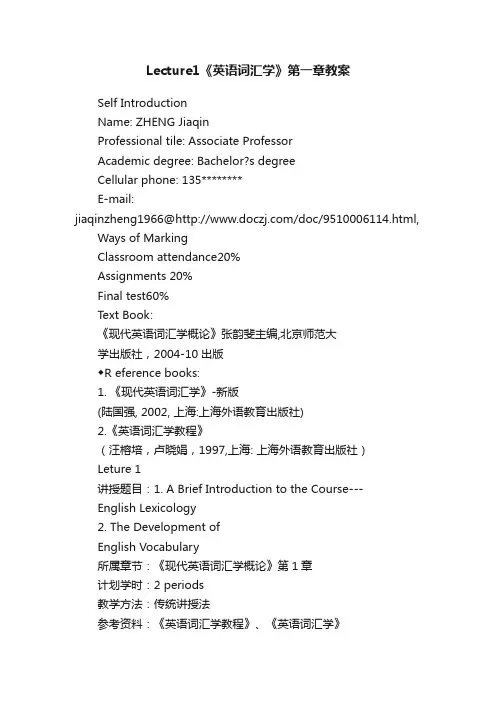
Lecture1《英语词汇学》第一章教案Self IntroductionName: ZHENG JiaqinProfessional tile: Associate ProfessorAcademic degree: Bachelor?s degreeCellular phone: 135********E-mail:jiaqinzheng1966@/doc/9510006114.html, Ways of MarkingClassroom attendance20%Assignments 20%Final test60%Text Book:《现代英语词汇学概论》张韵斐主编,北京师范大学出版社,2004-10出版◆R eference books:1. 《现代英语词汇学》-新版(陆国强, 2002, 上海:上海外语教育出版社)2.《英语词汇学教程》(汪榕培,卢晓娟,1997,上海: 上海外语教育出版社)Leture 1讲授题目:1. A Brief Introduction to the Course---English Lexicology2. The Development ofEnglish Vocabulary所属章节:《现代英语词汇学概论》第1章计划学时:2 periods教学方法:传统讲授法参考资料:《英语词汇学教程》、《英语词汇学》教学目的和要求:通过本单元的学习,学生对英语词汇学的研究对象、性质、特点以及英语语言的发展进程等基本知识有了一定的了解。
IntroductionWhat is linguistics?Generally speaking, linguistics can be defined as the scientificstudy of language. To be more exact, linguistics studies the general principles upon which all human languages areconstructed and operate as systems of human communication.LEXICOLOGY1.The term lexicology contains two Greek morphemes: “lexikon”and “logie”; the former means “word or phrase”, while the latter “learning or the study of”.2. The literal meaning is the “science of the word”.3. It is the study of the signification/meaning and application/uses of words.4. Lexicology is a branch of linguistics inquiring into the origins and meanings of words ( WNWD-Webster?s New World Dictionary of the American Language ).THE FIVE SUB-BRANCHES OF LEXICOLOGY 1.Semantics: the study of the meanings of words and other parts of language.2.Etymology: studies the meanings, origin and history of individual words and their development.3. Historical lexicology: studies from a historical point of viewthe development of vocabulary4. Phraseology(成语学): mainly deals with set expressionsand idioms.5. Lexicography: studies the writing and making ofdictionaries.English lexicologyEnglish lexicology deals with English words, their origin, meaning, morphological structures, semantic structures, sense relations , idioms, historical development, formation and usages.The Nature of English LexicologyEnglish lexicology is a theoretically-oriented course. It is chiefly concerned with the basic theories of words in general and of English words in particular. However, it is a practical course as well, for in the discussion, we shall inevitably deal with copious stocks of words and idioms, and many usages examples. Naturally, there will be a large quantity of practice involved.THE AIMS OF THIS COURSEOffer an insight into the origin and development of the Englishvocabulary.Give a systematic description of the English vocabulary.Discuss the problems of word-structure and word-formation Study the use of English words , their meanings and changes in meaning, their sense relations.THE SIGNIFICANCE OF THE COURSEDevelop your personal vocabulary and consciously increase your wordpower (active vocabulary).Understand word-meaning and organize, classify and store words moreeffectively.Raise your awareness of meaning and usages, use words more accurately and appropriately.Develop your skills and habits of analyzing and generalizinglinguisticphenomena in your learning experiences.Ultimately improve your receptive and productive skills in languageprocessing as well as language production.TWO APPROACHES TO THE STUDY OF ENGLISHLEXICOLOGYA synchronic approach is an approach to the study of a language at one period of time,A diachronic approach is an approach to the study of the change in a language that took place over a period of time.There are two approaches to the study of words, namely synchronic and diachronic. From a synchronic point of view, words can be studied at a point in time, disregarding whatever changes might be taking place. For example the word …wife? now means ……a married woman, esp. in relation to her husband??. This is the current meaning.It has an obsolete meaning …woman?, which is only preserved in midwife, housewife, Bathwife, etc. However if we take a diachronic perspective, we will consider the word historically, looking into its origin and changes in form and meaning. In this light, the word …wife? evolved from the old English … wif ?, meaning … woman?, but later it became specialized in the course of development to the modern meaning …a married woman?.TWO APPROACHES TO THE STUDY OF ENGLISHLEXICOLOGYModern linguistics is mainly synchronic, focusing on the present-day language (English words), but we need the diachronic approach as a supplement, for a knowledge ofhistorical development of the vocabulary will definitely be of great help to us in our language study.Questions and Tasks1. What is lexicology?2. What is the nature and scope of English lexicology?3. Why should a student of English study English lexicology?。
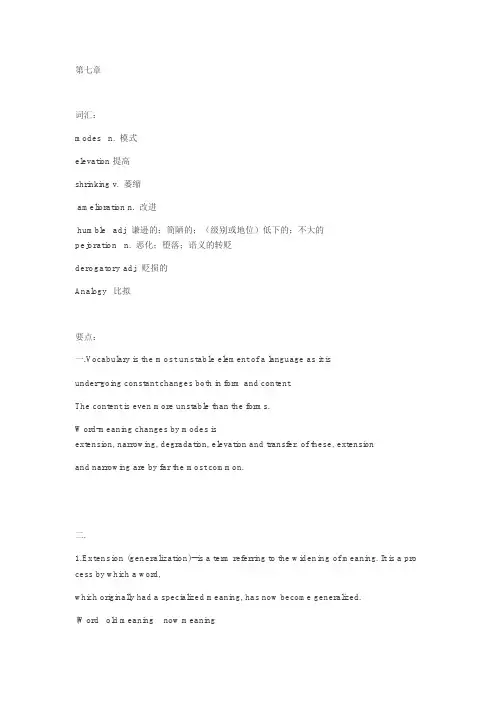
第七章词汇:modes n. 模式elevation 提高shrinking v. 萎缩amelioration n. 改进humble adj. 谦逊的;简陋的;(级别或地位)低下的;不大的pejoration n. 恶化;堕落;语义的转贬derogatory adj. 贬损的Analogy 比拟要点:一.Vocabulary is the most unstable element of a language as it isunder-going constant changes both in form and content.The content is even more unstable than the forms.Word-meaning changes by modes isextension, narrowing, degradation, elevation and transfer. of these, extensionand narrowing are by far the most common.二.1.Extension (generalization)--is a term referring to the widening of meaning. It is a pro cess by which a word,which originally had a specialized meaning, has now become generalized.(Word old meaning now meaningManuscript handwriting :any author‘s writing whether written by hand or typed with a type-writer or a word-processorFabulous resembling:a fable incredible, marvelousBarn :a place for storing only barley storeroomPicture painting include "drawings" and even "photographs".Mill place for grinding into flour place where things are ma deJournal daily paper periodicalButcher one who kills goats one who kills animalsCompanion one who shares bread a company·. A large proportion of polysemic words of modern English have their meanings extended sometimes in the course of development. Some words are generalized to such an extent that they can mean almost anything.Word old meaning now meaningThing a public assembly or a council anythingBusiness, concern, condition, matter, article, circumstance ·.Technical termsWord old meaning now meaningAlibi (a legal term) plea that the accused is not at the place excuseWhen the crime is committedAllergic (a medical term) too sensitive to medicine averse or disinclined toFeedback (computer term) response ·.From proper nounsWord old meaning now meaningLynch the Lynch‘s Law kill without lawful trialSandwish a gambler‘s name to denote a kind of fast place or squeeze betweenFood Vandal a member of an East Germanic tribe malicious destruction of a thingA person of such behaviourV. vandalize Adj. Vandalic/vandalistic n. vandalization/vandalism2. Narrowing (specialization) --is a term referring to the shrinking of meaning. It is a proc ess by which a word ofwide meaning acquires a narrower or specialized sense.Word old meaning now meaningDeer animal Corn grain maize Garage any safe place a place for storing carsLiquor liquid alcoholic drinkDisease discomfort illnessPoison drink poisonous drinkWife woman a married womanAccident event unfortunate eventGirl young person of either sex female young person.Turn into a proper nounsThe City business center of LondonThe Peninsula Iberian PeninsulaThe Prophet Mohammed.For economy, some phrases are shortened and only one element of the original is left t o retain the meaning ofthe whole.e.g. a private = a private solidera general = a general officeran editorial = an editorial article.Material nounsWord old meaning now meaningSilver silver dollarsGlass cup-like container or mirrorIron device for smoothing clothes3.Elevation or amelioration--refers to the process by which words rise from humble beg innings to positions ofimportance.Word old meaning now meaningNice ignorant --- foolish delightful, pleasantMarshal / constable keeper of horses high-ranking army officer / policemenAngle messenger messenger of GodKnight servant rank below baronetEarl men countGovernor pilot head of a stateFond foolish affectionateMinister servant head of ministryShrewd evil, wickedness smartNimble be good at taking things without permission smartChamberlain servant high official of royal courtsSuccess result4. Degradation or pejoration of meaning --It is a process whereby words of good origin fall into ill reputation ornon-affective words come to be used in derogatory sense.Word old meaning now meaningBoor peasant rude, ill-mannered personChurl peasant / free man uncultivated or mean personWench country girl prostituteHussy housewife woman of low moralsVillain person who worked in a villa evil or wicked person or scoundrelSilly happy foolishKnave boy dishonest personLewd ignorant lecherousCriticize appraise find fault withLust pleasure sexual desire5. Transfer- words which were used to designate on thing but later changed to meansomething else.Word old meaning now meaningPaper an African plant papyrus·Associated transferE.g. the lip of a woundThe tongue of a bellThe nose of a planePurse for money, dish for food, glass for cup·Between abstract and concrete meaningWord old meaning now meaningAftermath second crop of grass after mowing consequence, resultHope e.g. Clinton is the hope of the family.·Between subject and objective meaningWord old meaning now meaningPitiful full of pity deserving pityDreadful / hateful subject meaning objective meaningFearful/ doubtful / suspicious subject and objective meaning·Transfer of sensationsE.g. clear-sounding (from sight to hearing)Loud colours (from hearing to sight)Sweet music (from taste to hearing)三.1. Extra-linguistic Factors1). Historical reason·A word is retained for a name though the meaning has changed because the reference has changed.Word old meaning now meaningPen featherCar two-wheel cart drown by horses and used automobile in warComputer person who computes electronic machine·Increased scientific knowledge and discovery are also important factorsWord old meaning now meaningSun the luminous heavenly body-one of the star around which the earth and other p lanets revolveseven planets revolving around the earthAtom any of the indivisible particles not the smallest and can be divided into evensmaller particles2). Class reaso n. Language is just like a mirror, reflecting everything that exists inhuman society. It records the speech and attitude of different social classes.As a result, different social varieties of language have come into being.Word old meaning now meaningChurl, hussy, wench, villain ill-mannered or bad peopleDemocracy, revolution, liberalism, human rights, communism different meaning in different societies and to different people3). Psychological reason. The associated transfer of meaning and euphemistic use of words are often due to psychological factors. people change word-meaning owingto various psychological(slang). Religious influence isanother kind psychological need.Word old meaning now meaningCopperhead a venomous snake2. Linguistic factors1). ShorteningGold for gold medalGas for coal gasBulb for light bulbPrivate for private solider2).BorrowingDeer / animal / beastPig / pork, sheep / mutton, cattle / beefBird / fowl, dog / hound, boy / knave, chair / stool3). AnalogyFortuitous happening by chance, accident fortunateFruition a pleasure obtaining from using or possessing something。
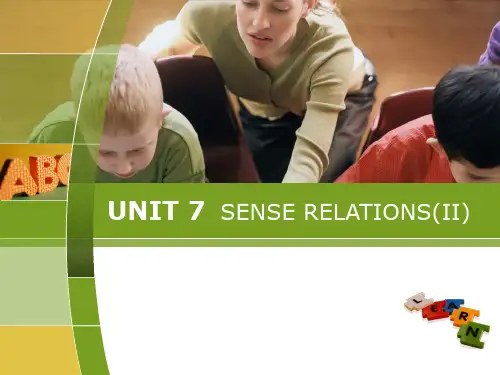
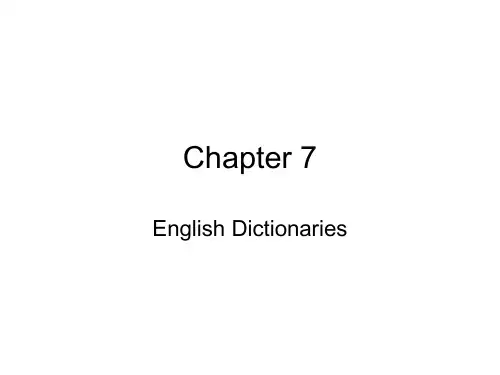
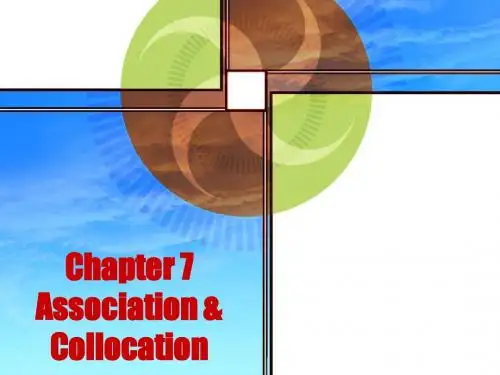
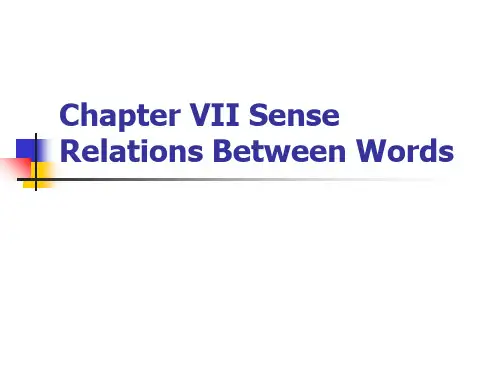
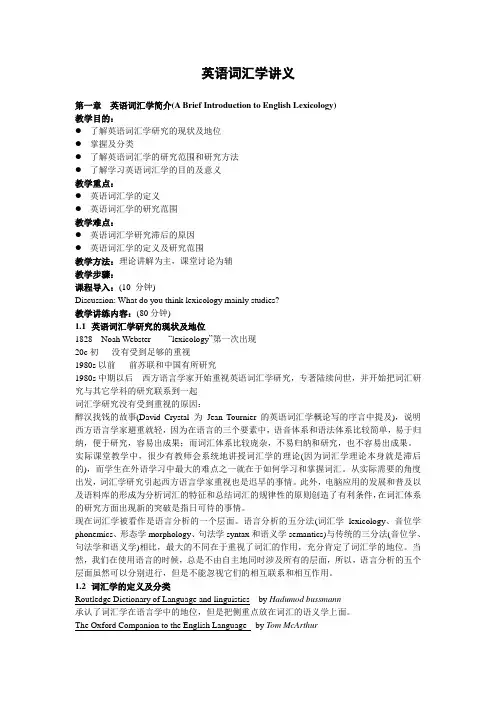
英语词汇学讲义第一章英语词汇学简介(A Brief Introduction to English Lexicology)教学目的:●了解英语词汇学研究的现状及地位●掌握及分类●了解英语词汇学的研究范围和研究方法●了解学习英语词汇学的目的及意义教学重点:●英语词汇学的定义●英语词汇学的研究范围教学难点:●英语词汇学研究滞后的原因●英语词汇学的定义及研究范围教学方法:理论讲解为主,课堂讨论为辅教学步骤:课程导入:(10 分钟)Discussion: What do you think lexicology mainly studies?教学讲练内容:(80分钟)1.1英语词汇学研究的现状及地位1828 Noah Webster “lexicology”第一次出现20c初没有受到足够的重视1980s以前前苏联和中国有所研究1980s中期以后西方语言学家开始重视英语词汇学研究,专著陆续问世,并开始把词汇研究与其它学科的研究联系到一起词汇学研究没有受到重视的原因:醉汉找钱的故事(David Crystal 为Jean Tournier 的英语词汇学概论写的序言中提及),说明西方语言学家避重就轻,因为在语言的三个要素中,语音体系和语法体系比较简单,易于归纳,便于研究,容易出成果;而词汇体系比较庞杂,不易归纳和研究,也不容易出成果。
实际课堂教学中,很少有教师会系统地讲授词汇学的理论(因为词汇学理论本身就是滞后的),而学生在外语学习中最大的难点之一就在于如何学习和掌握词汇。
从实际需要的角度出发,词汇学研究引起西方语言学家重视也是迟早的事情。
此外,电脑应用的发展和普及以及语料库的形成为分析词汇的特征和总结词汇的规律性的原则创造了有利条件,在词汇体系的研究方面出现新的突破是指日可待的事情。
现在词汇学被看作是语言分析的一个层面。
语言分析的五分法(词汇学lexicology、音位学phonemics、形态学morphology、句法学syntax和语义学semantics)与传统的三分法(音位学、句法学和语义学)相比,最大的不同在于重视了词汇的作用,充分肯定了词汇学的地位。
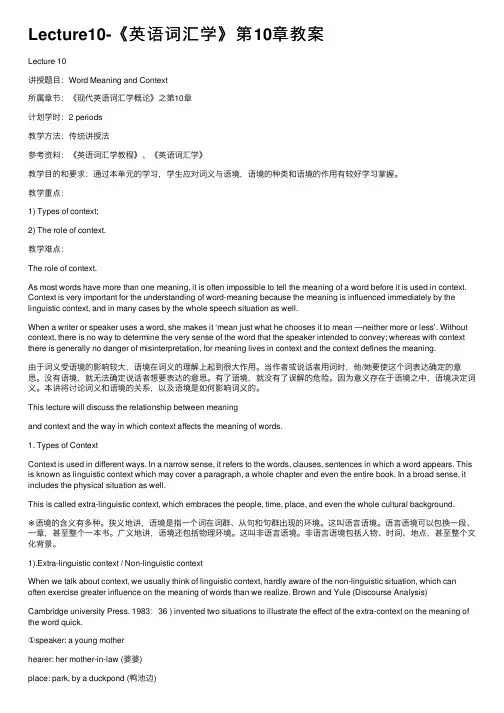
Lecture10-《英语词汇学》第10章教案Lecture 10讲授题⽬:Word Meaning and Context所属章节:《现代英语词汇学概论》之第10章计划学时:2 periods教学⽅法:传统讲授法参考资料:《英语词汇学教程》、《英语词汇学》教学⽬的和要求:通过本单元的学习,学⽣应对词义与语境,语境的种类和语境的作⽤有较好学习掌握。
教学重点:1) Types of context;2) The role of context.教学难点:The role of context.As most words have more than one meaning, it is often impossible to tell the meaning of a word before it is used in context. Context is very important for the understanding of word-meaning because the meaning is influenced immediately by the linguistic context, and in many cases by the whole speech situation as well.When a writer or speaker uses a word, she makes it ‘mean just what he chooses it to mean —neither more or less’. Without context, there is no way to determine the very sense of the word that the speaker intended to convey; whereas with context there is generally no danger of misinterpretation, for meaning lives in context and the context defines the meaning.由于词义受语境的影响较⼤,语境在词义的理解上起到很⼤作⽤。
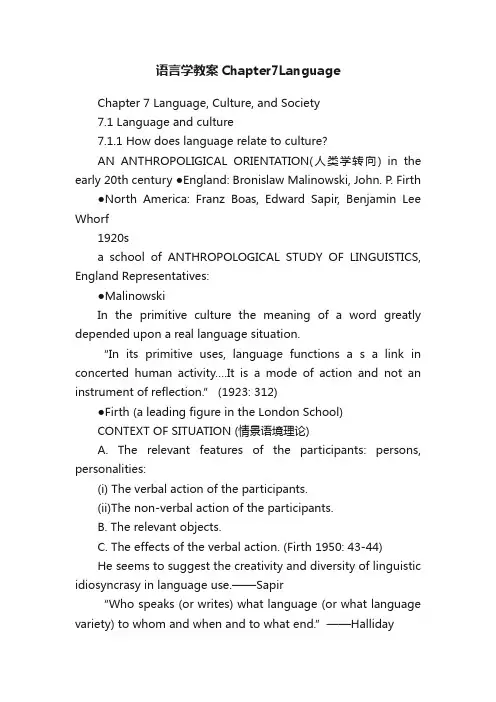
语言学教案Chapter7LanguageChapter 7 Language, Culture, and Society7.1 Language and culture7.1.1 How does language relate to culture?AN ANTHROPOLIGICAL ORIENTATION(人类学转向) in the early 20th century ●England: Bronislaw Malinowski, John. P. Firth●North America: Franz Boas, Edward Sapir, Benjamin Lee Whorf1920sa school of ANTHROPOLOGICAL STUDY OF LINGUISTICS, England Representatives:●MalinowskiIn the primitive culture the meaning of a word greatly depended upon a real language situation.“In its primitive uses, language functions a s a link in concerted human activity….It is a mode of action and not an instrument of reflection.” (1923: 312)●Firth (a leading figure in the London School)CONTEXT OF SITUATION (情景语境理论)A. The relevant features of the participants: persons, personalities:(i) The verbal action of the participants.(ii)The non-verbal action of the participants.B. The relevant objects.C. The effects of the verbal action. (Firth 1950: 43-44)He seems to suggest the creativity and diversity of linguistic idiosyncrasy in language use.——Sapir“Who speaks (or writes) what language (or what language variety) to whom and when and to what end.”——HallidayEarly 1920sNorth American linguistics, the relations between language and culture (the American Indian culture)1920s—1940sBoas, Sapir, and Whorf: to reconstruct American Native languageThe culture is significant in the study of language.●SAPIR-WHORF HYPOTHESISThe language helps mould the way of thinking and, consequently, different language may probably express the unique ways of understanding the world.Language may determine the thinking patterns.LINGUISTIC DETERMINISM (语言决定论)Similarity between languages is relative, the greater their structural differentiation is, the more diverse their conceptualization of the world will be.LINGUISTIC RELATIVITY (语言相对论)●Eugene NidaFive types of sub-culture in CROSS-CULTURALCOMMUNICATION1) ecological culture; 2) linguistic culture; 3) religious culture;4) material culture; 5) social culture7.1.2 More about the Sapir-Whorf hypothesisThe language helps mould the view of the world.A strong version(强式说)and a weak version(弱式说)The strong version: the claim that the original hypothesis suggests, emphasizingthe decisive role of language as the shaper of the thinking patternsThe weak version: a modified type of its original theory,suggesting that there is acorrelation between language, culture, and thought, but the cross-cultural differences thus produced in the ways of thinking are relative, rather than categorical.Example 1: to prove that languages may differ from each otherHopi in Arizona: timeless language (Pp229)Question : Is it possible to compare different linguistic representations?Criticism : The hypothesis is based on establishing European languages as a model against which all comparisons are made. Similarities are more important than differences when LINGUISTIC UNIVERSALITY(语言的普遍性) is concerned. ? Example 2:to prove that the assumption that language is culturally determinedand hence absolutely different from one another is wrong Dugum DaniColor terms are not culturally determined and hence absolutely different from one another. Different language might undergo a universal evolutionary process of development which, in turn, made the basic color system in one language different from that in another only in terms of the stages of their evolution.< [red] < < [blue]<[brown]< Evolutionary Stages of Basic Color Words(Berlin & Kay 1969: 4)7.1.3 Case Study (See Pp 232-233)7.1.4 To which extent do we need culture in our linguistic study?Watergate, Billy gate , Debate gate , Cattle gate , Rice gate1) Watergate as a word taking on a pejorative implicature torefer to any political scandal at the high rank, will stay in English for quite a long time;2) Its structural status in the language becomes rather stable through the rich derivational process it has undergone in word-formation.3) The semantic implicature it has will say with the word for quite a long time.7.1.5 Culture in language teaching classroom1) To get the students familiar with cultural differences;2) To help the students transcend their own culture and see things as the members of the target language;3) To emphasize the inseparability of understanding language and understanding culture through various classroom practices.7.2 Language and society7.2.1 How does language relate to society?the whole 20th centuryWhite black green yellow purple pink orange graya MONSTIC or AUTONOMOUS PURSUIT of an independent language1960sDUALISTIC VIEW7.2.2 A situationally and socially variationist perspective“You are what you say”(Lakoff 1991).Factors influencing the language behaviors1) class; 2) gender; 3) age; 4) ethnic identity;5) education background; 6) occupation; 7) religious beliefExample 1: Class factorThe middle of 1960s, William Labov, phonological variants Example 2: Gender factor (1970s Robin Lakoff)1) Women use more “fancy ” color terms such as mauve and beige;2) Women use less powerful curse words;3) Women use more intensifiers such as terrible and awful;4) Women use more tag questions;5) Women use more statement questions like “Dinner will be ready at seveno’clock?”(with a rising i ntonation at the end);6) Women’s linguistic behaviour is more indirect and, hence, more polite than men. LINGUISTIC SEXISM (语言性别歧视): It is the not the language itself but women’s place in society that influences linguistically behave.7.2.3 What should we know more about sociolinguistics?7.2.4 What implications we can get from sociolinguistics?Classroom teaching: grammarians or active language users? COMMUNICATIVE COMPETENCE (Hyme 1970s)Law courts; clinical settings7.3 Summary。
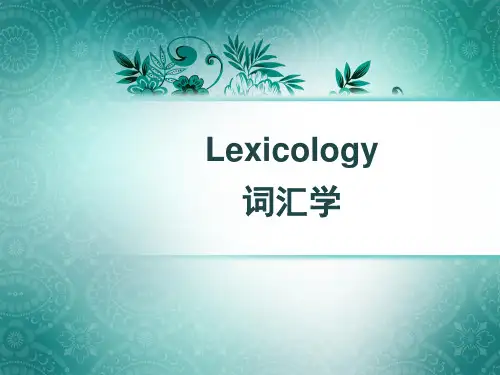
《词汇学》教案英语词汇学课程Chapter I The basic concepts of words and vocabulary1.1 What is a word?A word is a minimal free form of a language that has a given sound, meaning and syntactic function. 词是具有一定的声音、意义和语法功能,能独立运用的最小的语言单位。
1.2 What is vocabulary?The total number of the words in a language.All the words used in a particular historical period.All the words of a given dialect, a given book, a given discipline and the words possessed by an individual person.1.3 Sound and meaningWhat’s the relationship between s ound and meaning? Arbitrary, Conventional1.4 Sound and formWhat causes the differences between sound and form?More morphemes than letters,Stabilization of spelling,Deliberate change of spelling by early, scribes for easier recognition,Borrowing of foreign words.1.5 Classification of wordsCriterion: by use frequency:Basic word stock,Non-basic vocabularyCriterion: by notion:Content words,Functional wordsCriterion: by origin:Native words,Borrowed words1. Basic word stock and non-basic vocabulary基本词汇和非基本词汇Five basic features of the basic word stockAll national character 全民性, Stability 稳定性, Productivity 能产性, Polysemy 多义性, Collocability 搭配能力强Non-basic vocabularyTerminology 专业术语, Jargon 行话, Slang 俚语, Argot 隐语, Dialectal words 方言词, Archaisms 古语词, Neologisms 新词语2. Content words and functional words 实义词和功能词Content words/Notional words/Lexical wordsConstitute the main body of the English vocabulary, numerous and the number is ever growingFunctional words/Empty/form words/Grammatical wordsConstitute a very small number of the vocabulary; stable3. Native words and borrowed words 本族语词和外来语词Native words / Angle-Saxon wordsThe features of native wordsBorrowed words/ loan words / borrowingsDenizens同化词Aliens 非同化词Translation-loans 译借词Semantic loans 语义借词Denizens are words borrowed early in the past and now are well assimilated into the English language. 同化词指早期借入, 其拼写和读音完全符合本族语词规范的借词。
Lecture 7讲授题目:Word Meaning所属章节:《现代英语词汇学概论》之第5章计划学时:2 periods教学方法:传统讲授法参考资料:《英语词汇学教程》、《英语词汇学》教学目的和要求:通过本单元的学习,让学生对词的意义、词义的理据和词义的类别等知识有基本的了解和认识。
教学重点:①Some basic notions: meaning , reference, concept and motivation;②Semantic triangle;③Four types of motivations④Classification of word meaning教学难点:①Four types of motivations②Classification of word meaningWord meaningThe relationship between language and the world conceptworld languageWord meaningThought or reference (concept)ReferentSymbol(object in the world) (word, sentence ) Ogden & Richards‟ the semiotic triangleThe semantic triangleAccording to Ogden and Richards, the symbol is the linguistic element, that is the word ,sentence ,etc., and the referent is the object,etc. , in the world of existence, while thought or reference is concept. This is called the semantic triangle.奥德根和理查德提出的“语义三角”的基本观点是:概念、思想和符号(即字词)发生直接联系,而与“所指客体/事物”(即现实世界和人的经历)并不存在直接联系。
它们之间的关系要求助与概念/思想。
所以,符号(字词)与客体(所指物体/事物)之间用虚线。
•Triangle of significance(词义三角)w h a t’s i n a n a m e?T h a t w h i c h w e c a l l a r o s eB y t h e o t h e r n a m eW o u l d s m e l l a s s w e e t--- sh k e s p e a r e名称本无意此物谓玫瑰若以他名易香气亦相宜1. Meaning“Meaning” refers to the association of language symbols with the real world.—“意义”指的是语言符号与客观世界的一种关联。
客观事物反映在人脑中,产生感觉(sensation)、知觉(perception)、表象(representation);人脑把三者加以概括和抽象,形成概念(concept)。
人的用语言形式把概念固定下来,成为人们交流思想的符号(sign),这就是有一定意义的词。
也就是说,词的意义是“人”赋予的。
英国语言学家--Eric Partridge (帕特里奇)说过,“Words have no meaning; people have meaning for them” (词本无义,人赋予之)。
2.ReferenceThe reference of a word to a thing outside the language is arbitrary and conventional. The connection is the result of generalization andabstraction. With the help of context, it can refer to something definite.3. Referent----referent is the object,etc. , in the world of existence.4.ConceptConcept which is beyond language is the result of human cognition, reflecting the objective world in the human mind. It is universal to all men alike regardless of culture, race, language and so on. The same concept can be expressed in different words.Thought or reference is concept.5.SenseEvery word that has meaning has sense but not every word has reference.6.motivationMotivation refers to the connection between the linguistic symbol and its meaning.Most words :non-motivatedSome words: transparent and reasonably explicable ——词的理据讨论的是语言符号和意义之间的联系。
也就是语言符号与客观事物和现实联系的依据。
1) Onomatopoeic Motivation (拟声理据)In modern English one may find some words whose sounds suggest their meanings, for these words were created by imitating the natural sounds or noises. For example, bow-wow ——汪汪(犬吠声); bang (砰); cuckoo (布谷鸟); tick-tuck ——嘀嗒声(钟表声); ha ha, etc.woof-woof (汪汪)of a dogthe moo(哞)of a cowthe miaow of a catthe bang of a doorthe crack (啪)of a pistol shot2) Morphological Motivation (形态/构词理据)compounds and derived words are multi-morphemic words and the meanings of many are the sum total of the morphemes combined.Quite often, if one knows the meaning of each morpheme, one can figure out the meaning of the word. For instance, airmail (航空信) means to …mail by air‟, reading-lamp is the …lamp for reading‟, miniskirt is a …a small、short skir t‟ and hopeless means …without hope‟.It should be pointed out that there are a lot of words whose structures are opaque, i.e. their meanings are not the combinations of the separate parts. Blackmarket, for example, is by no means the …market black in color‟, but it refers to …illegal selling and buying‟. Likewise, greenhorn is not …the horn green in color‟, but …a newcomer‟.Not all compounds are motivatedeggplant, Indian summer, dog days(茄子,小阳春,伏天)3) Semantic Motivation (语义理据)Semantic motivation refers to the mental associations suggested by the conceptual meaning of a word. It explains the connection between the literal sense and figurative sense of the word.——语义理据指由词的概念意义所暗示的联想意义。
这种理据解释词的文字意义和比喻意义之间的联系。
e.g. When we say …the mouth of a river‟, we associate the opening part of the river with the mouth of a human being or an animal.In the sentence …He is fond of the bottle‟, bottle reminds one of what is contained inside.a stony heartthe hour handthe minute handthe leg of a table4) Etymological Motivation (词源理据)The meanings of many words often relate directly to their origins.In other words, the history of the word explains the meaning of the word.For example, now people use pen for any writing tool though it originally denotes …feather‟, because before modern pens were created, feather were commonly used as writing tool. Though people in modern times no longer use feathers in writing, for the sake of convenience, the name is retained.Another example is the word laconic,meaning …brief‟ or …short‟, which is derived from Lacons, a tribe of peo ple who were known for their …brevity of speech‟ and for their habit of never using more words than necessary. Hence … a laconic answer ‟ is a …short answer‟.china porcelain or ceramic ware (originally imported from China)japan a hard varnish (brought from Japan)braille from the creator Louis Braillewalkman from a trade mark7. Main types of word meaningWord meaning is made up of various components which are interrelated and interdependent.Grammatical meaning and lexical meaning make up the word Meaning.Main types of word meaning1). Grammatical meaning refers to that part of meaning of the word which indicates grammatical concept or relationships such as part of the speech of words, singular and plural meaning of nouns, tense meaning of verbs and their inflectional forms (forget, forgets, forgot, forgotten,forgetting).※Functional words, having little lexical meaning, but possess strong grammatical meaning whereas content words have both meanings, and lexical meaning in particular.2). Lexical meaningLexical meaning is the meaning of an isolated word in adictionary.Lexical meaning has two components: conceptualmeaning and associative meaning.(1). Conceptual meaning and associative meaning Conceptual meaning is the meaning given in the dictionary and forms the core of word-meaning. It is relatively constant and stable. For example, the word sun means …a heavenly body which gives off light, heat, and energy‟, a concept which is understood by anyone who speaks English.(2). Associative meaning is the secondary meaning …supplemented (added) to the conceptual mean ing. Associative meaning comprises four types: …Connotative(内涵意义), stylistic (文体意义), affective (情感意义)and collocative (搭配意义).①Connotative meaningConnotative meaning refers to the overtones(言外之意)or associations suggested by conceptual meaning, traditionally known as connotations.For example, mother, denoting a …female, parent‟, is often associated with …love‟, …care‟, …tenderness‟, …forgiving‟, etc.These connotations are not given in the dictionary, but associated with word in actual context to particular readers or speakers.Connotative meaning is unstable, varying considerably according to culture, historical period, and the experience of the individual. For example, the phrase …son of bitch‟ which normally has anassociative meaning of crude vulgarity may convey a connotation of …friendliness‟ and …intimacy‟ used between two close friends when they meet after some prolonged period of time, e.g. …And how are you doing, you old son of bitch‟.②Stylistic meaningApart from their conceptual meanings, many words have stylistic features, which make them appropriate for different contexts. In some dictionaries, these stylistic features are clearly marked as …formal‟, …informal‟, …literary‟, …archaic‟, …slang‟ and so on.But people generally, do not go that far. We normally classify styles into …formal‟, neutral‟ and …informal‟.domicile —— very formal, officiale.g 住宅residence —— formal or humorousabode —— literaryhome ——general③Affective meaningAffective meaning indicates the spanker‟s attitude towards the person or thing in question.Words that have emotive values may fall into two categories: appreciative and pejorative. One aspect should be pointed out that the affective meaning of most English words are neutral.e.g. appreciative neutral pejorativecomrade friend crony(狐朋狗友)senior citizen old person fossilunclothed naked nudeslender / slim thin skinnyscholar student bookwormportly overweight tubby④Collocative meaningThis meaning consists of the associations a word acquires in its collocation. The synonyms of pretty and handsome offer good illustration.These two words share the conceptual meaning …good-looking‟, butare distinguished by the range of nouns they collocate with:It may be pointed out that there is some overlap between thecollocations of the two words, e.g. Pretty woman and handsomewoman. Though both are perfectly correct, yet they suggest a different kind of attractiveness. A pretty woman stresses the attractiveness of facial feature while a handsome woman may notfacially beautiful yet is attractive in other respects: a slender figure,posture, behaviour, etc.The same is true of tremble and quiver, both meaning …shake involuntarily‟, but people tremble with fear and quiver with excitement, showing different implications.。